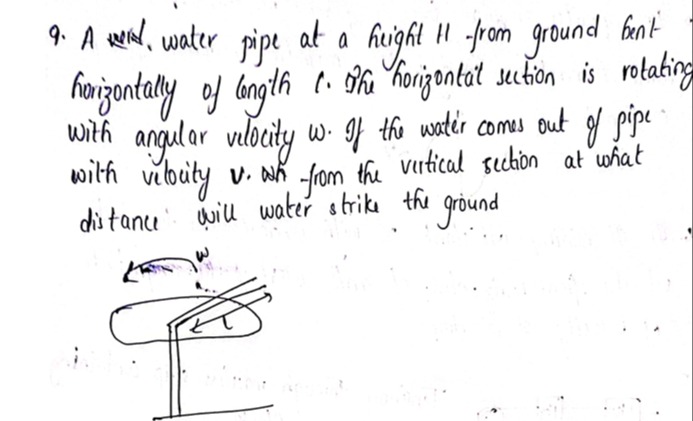Question
Question: A weid, water pipe at a height H from ground bent horizontally of length $l$. The horizontal section...
A weid, water pipe at a height H from ground bent horizontally of length l. The horizontal section is rotating with angular velocity ω. If the water comes out of pipe with velocity v, wh from the vertical section at what distance will water strike the ground.

l2+2vlg2H+(v2+l2ω2)g2H
Solution
The problem describes water flowing out of a rotating horizontal pipe at a certain height. We need to find the horizontal distance from the vertical section (axis of rotation) where the water strikes the ground.
1. Identify the components of initial velocity of water:
When water leaves the pipe, its absolute velocity is a vector sum of two components:
- Velocity of water relative to the pipe (vr): The problem states "water comes out of pipe with velocity v". This is the velocity of water relative to the pipe, directed radially outwards along the pipe. So, vr=v.
- Tangential velocity of the pipe end (vt): The horizontal section of the pipe has length l and rotates with angular velocity ω. The end of the pipe, from where water exits, has a tangential velocity vt=lω.
These two velocity components (vr and vt) are perpendicular to each other. Therefore, the magnitude of the resultant horizontal velocity of the water as it leaves the pipe is:
VH=vr2+vt2=v2+(lω)2
2. Determine the time of flight:
The water leaves the pipe at a height H from the ground with an initial vertical velocity of zero (since it's a horizontal pipe). The time taken for the water to fall to the ground (t) can be found using the equation of motion in the vertical direction:
H=Vy0t+21gt2
Since Vy0=0:
H=21gt2
t2=g2H
t=g2H
3. Calculate the horizontal displacement:
The horizontal motion of the water is independent of its vertical motion. The water travels horizontally with constant velocity components.
Let's set up a coordinate system. Assume the vertical section of the pipe is along the z-axis. The point of exit of water is at a radial distance l from the z-axis.
At the moment the water leaves the pipe, let's align the pipe along the x-axis for simplicity.
- Initial position of water: (x0,y0,z0)=(l,0,H).
- Initial velocity components: Vx=v (radial component), Vy=lω (tangential component).
The horizontal displacement during time t will be:
Δx=Vxt=vg2H
Δy=Vyt=lωg2H
The final coordinates of the water on the ground are:
Xfinal=x0+Δx=l+vg2H
Yfinal=y0+Δy=0+lωg2H=lωg2H
4. Calculate the distance from the vertical section:
The vertical section is the axis of rotation. Its projection on the ground is the origin (0,0). The distance from the vertical section is the straight-line distance from the origin to the point (Xfinal,Yfinal) on the ground.
Distance D=Xfinal2+Yfinal2
D=(l+vg2H)2+(lωg2H)2
Expanding the terms:
D=l2+2vlg2H+v2(g2H)+(lω)2(g2H)
D=l2+2vlg2H+(v2+l2ω2)g2H
The final answer is l2+2vlg2H+(v2+l2ω2)g2H.
Explanation of the solution:
The water leaving the rotating pipe has two perpendicular initial horizontal velocity components: radial velocity v (relative to the pipe) and tangential velocity lω (due to pipe rotation). The time for the water to fall from height H is t=2H/g. During this time, the water travels horizontally. The final horizontal position is the vector sum of the initial radial position l and the displacements due to the radial and tangential velocity components over time t. The total distance from the vertical section is the magnitude of this final position vector.
